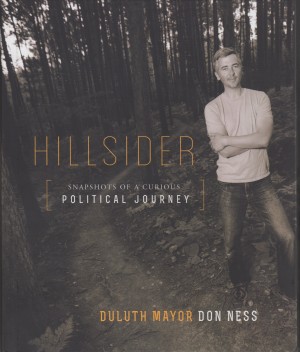
Hillsider: Snapshots of a Curious Political Journey by Don Ness (2015. Hillside Publishing. ISBN 9780692490129)
Political memoir can be a tricky thing to pull off. Oft times, the author, who also happens to be the subject of the writing, lets his or her ego skew the accuracy of the reportage. I’ve dipped my pen in the ink of memoir on occasion (my collection of essays Black Water is essentially memoir) but I don’t claim to be an expert in the genre. Still, as an avid reader of just about every sort of fiction and non-fiction tome that comes along, I think I have enough readerly expertise to comment on autobiographical work. Here’s what I have to say about this coffee table sized collection: It rocks. From page 1 to page 279, the out going mayor of Duluth, my hometown, has written a quirky, engaging, prose poem to the city on the lake and has managed to, in words, poetry, cartoons, and stunning photography, convey his personal and political vision of where Duluth was and where it might be headed.
For those of you unfamiliar with Duluth’s recent past, at the time Don Ness was learning to walk, the city, a once proud industrial, shipping, and railroad powerhouse, began a precipitous and calamitous decline. Projected at the beginning of the 20th century to rival Chicago as a manufacturing capital and clearing house for commodities such as grain and iron ore, and often called the San Francisco of the Midwest due to the city’s steep hills, nervously poised buildings, and spectacular views, by the early 1970s, my town, Mayor Ness’s town, had succumbed to plant closings and layoffs (U.S. Steel, Atlas Cement, American Hoist, Clyde Iron, the U.S. Air Force, to name a few entities that left town) which reduced the city’s population from 106,000 to less than 87,000 souls. There followed, during my high school and college and early professional career and Mayor Ness’s youth and adolescence, a continuum of city political leaders who tried to undo the damage by luring large corporations to town through lucrative governmental enticements or through the cutting of taxes. Nothing worked. Even the few success stories in this regard (the Northwest Airlines maintenance facility is one that comes to mind) eventually failed. The city was filled with depressed, backward thinking folks longing for the “good old days” of solid blue collar wages and a long-lost economy.
Beginning with his naive and youthful campaign for city council, Don Ness entered the political arena with a different philosophy than “us against them”, the residual fear and loathing of the outsider that had permeated Duluth’s political and commercial thinking for the better part of three decades. Rather than put public money on the roulette wheel to tempt outside interests into believing in Duluth and investing in Duluth, Ness, at the outset and throughout his career, has looked to the natural beauty of the city, the strong minds and backs of its citizens, and the wisdom of native city fathers and mothers to raise Duluthians from the rust and dust of decline. This book, the most beautifully produced vision of this new approach, this new city on the hill, that I’ve come across isn’t simply an elegy to Ness’s work and ethic. It’s a collection of the “best of” our city has to offer, from the poetry of Louis Jenkins, to the photographs of Dennis O’Hara, to the essays (some prophetic, some quirky) by the mayor, to the cartoons of Chris Monroe chronically Duluth’s renaissance as a vibrant, relevant, happening, productive place. For a town of this size to have produced both Low and Trampled by Turtles, two internationally known bands that still call Duluth’s rocky hillside home, while also cultivating the incubation of the new Cirrus Vision jet and Maurice’s world headquarters, such success, given where we were twenty years ago, is simply remarkable. Would Outside Magazine or Google have looked Duluth’s way if the town was still trying to bring in a steel mill to replace the dinosaur that was shuttered in 1972? Or has the town been in the national news and in the national public eye because it’s developing a new ethic, a new version of itself that includes the revitalization of Old Downtown, reopening the NorShor, the creation of biking and hiking trails, and the renovation of the city’s public schools? To be clear, Mayor Ness didn’t accomplish this makeover on his own. Groundwork was laid by his political predecessors and by civic leaders, educators, and deep thinkers. But the story of bringing a town, steeped in depressing failure after failure when economic home run after economic home run became routine fly balls, into the 21st century is due largely to Ness’s collaboration with other young progressives. On the slick and well designed pages of this unusual book, the mayor is clear to thank those who showed him missteps, worked hard to help him correct his mistakes, and tried to guide the mayor’s vision of a new Duluth in ways that were positive and productive. Hillary’s “It takes a village” is apparent throughout the narrative.
Woven throughout the volume are pieces of writing from the mayor, his wife, and others. But this is mainly Don Ness’s effort. The book is filled with Ness’s sweat and blood and tears. Here’s a snippet from one of the best pieces in Hillsider wherein the author describes winter in Duluth:
Even the hum and thrum of the city sounds can’t get through it. The city feels paused. On nights like this, I cherish the silent expanse between snowflakes that allows me to sit, breathe, think slowly, and disappear into my chair, then into hushed totality, and finally into the city itself.
Poetic, energetic, visionary. But flawed, like all the rest of us, Mayor Ness has done a remarkable job of chronicling his role as a city leader for the past sixteen years in this effort.To be sure, some of the sillier pieces left me puzzled as to why an essay or story was included. But overall, the writing is crisp, the opinions honest, and the personal and professional history as framed by the author, warts and all, accurate.
Unfortunately for Duluth, Don Ness is leaving office. He has chosen not to seek re-election. His legacy is up for grabs. In a few weeks, Duluthians will decide whether the portrayal of Duluth’s resurgence in this book merits continued support or whether there needs to be a return to the “more of the same” politics and problem solving that left the town dying by the pricks of a thousand needles.
4 stars out of 5 for the content; 5 stars out of 5 for the design and layout.
Peace.
Mark


